The Cretaceous (145 to 66 million years ago) represents the last and longest period of the Mesozoic Era. With a warm climate and high sea levels, this period bore witness to the peak of dinosaur evolution. The Cretaceous denizens were such strange and ferocious creatures that a glimpse into that era would seem alien to the modern human.
You know who they are, let’s not waste any time and dive right in!
1. Tyrannosaurus Rex: “Tyrant Lizard King”
| Family | Tyrannosauridae |
| Found in | Golden, Colorado |
| Diet | Carnivorous |
| Lived | 90-66 mya |
| Length | 12 m |
| Height | 5 m |
| Weight estimate | 8000 kg |
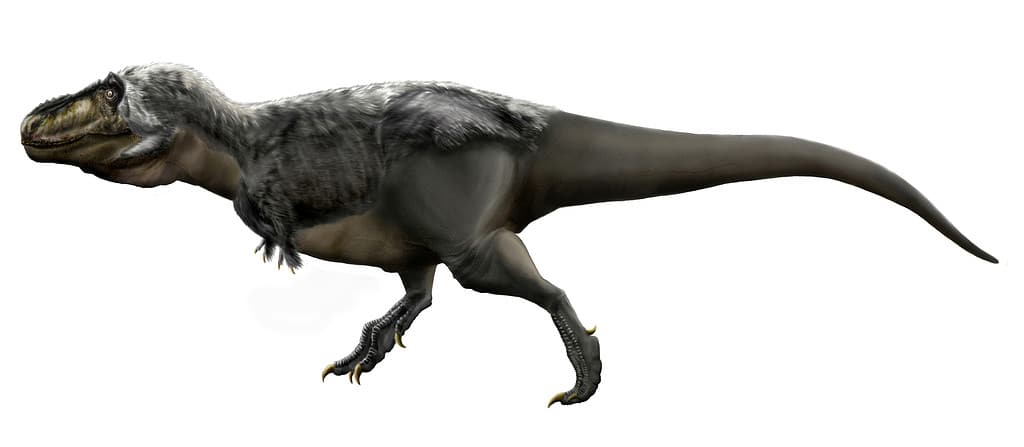
First discovered in the early 20th century, Tyrannosaurus rex is currently the dinosaur with the largest fossil record. This ABSOLUTE UNIT, dominant in the Late Cretaceous, could grow up to 5 meters in height and 12 meters in length. Known for its massive skull and robust teeth, T. rex had the strongest bite force in Earth’s history. Scientists estimate the Rex had a bone-crushing 35,000-newton bite. Despite its depiction in Jurassic Park, T.rex had excellent eyesight. Its binocular vision provided depth perception, while its highly developed olfactory bulbs suggest a keen sense of smell, likely used to track prey over great distances.
Tyrannosaurus‘ hunting tactics remain a topic of debate, with theories suggesting it was both a hunter and a scavenger. Its morphology underwent significant changes as it grew. Juveniles were leaner and faster, adapting to different ecological niches than their bulkier adults. This ultimate killing machine truly was the undisputed king of its time.
2. Triceratops: “Three-Horned Face”
| Family | Ceratopsidae |
| Found in | Denver, Colorado |
| Diet | Herbivorous |
| Lived | 68-66 mya |
| Length | 9 m |
| Height | 3 m |
| Weight estimate | 12,000 kg |
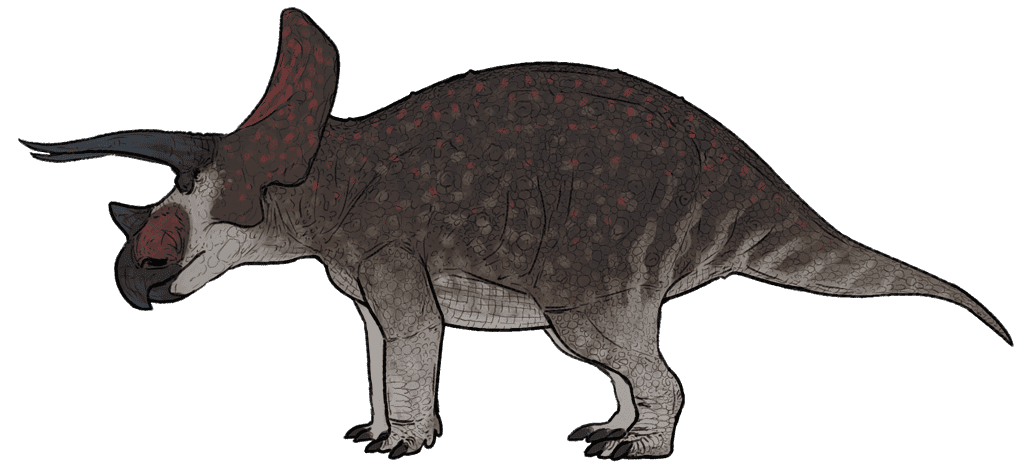
First unearthed in the late 19th century, Triceratops is distinguished by its iconic “three-horned face” and large bony frill. This herbivore roamed North America during the Late Cretaceous, measuring up to 9 meters in length. Triceratops had a massive skull, comprising nearly one-third of its body length, equipped with a sturdy beak and rows of teeth designed for shredding plants. Moreover, the discovery of bone beds containing multiple individuals hints at a social aspect of Triceratops life, suggesting that these dinosaurs might have moved in herds.
The function of its three horns and frill has been debated. Intuitively, studies suggest they were used in defense against predators like T. rex and combat against each other. The horns and frill may have also played crucial roles in social signaling and identification. Variations in frill shape and horn orientation observed in different specimens indicate a possible visual display function, potentially used in courtship rituals or establishing dominance hierarchies within herds. Additionally, Triceratops had blood vessel tracks in the bone structure of the frill meaning it could have used it for thermoregulation or as a means of intimidation through vivid color displays.
3. Velociraptor: “Swift Thief”
| Family | Dromaeosauridae |
| Found in | Gobi Desert, Mongolia |
| Diet | Carnivorous |
| Lived | 99-65 mya |
| Length | 2 m |
| Height | 0.5 m |
| Weight estimate | 20 kg |
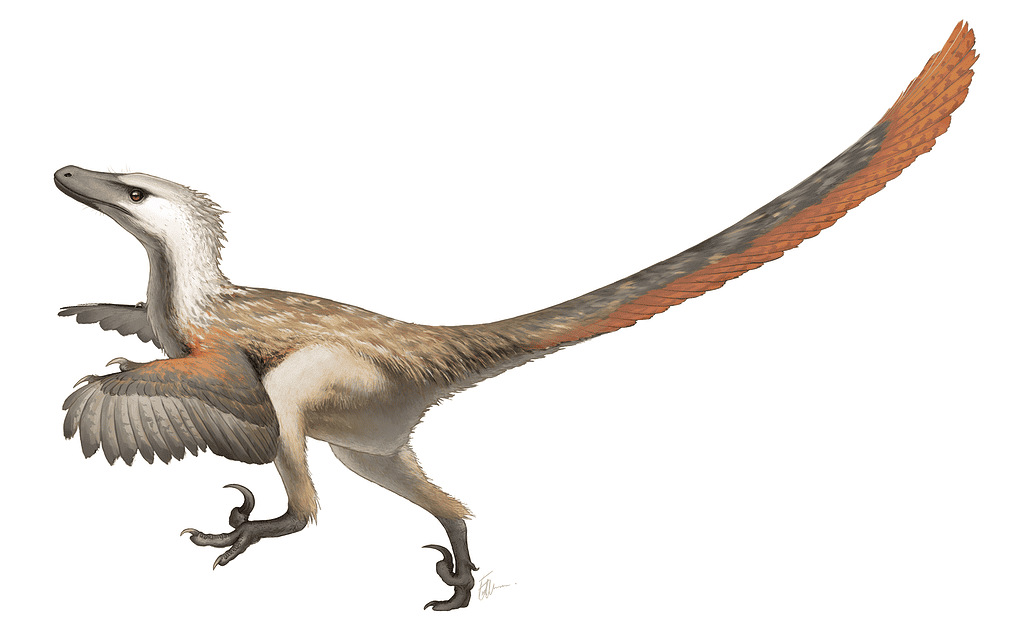
Velociraptor, the ‘swift thief’, is an iconic dinosaur in popular culture, though often with exaggerated features. This Cretaceous raptor made its first appearance when its fossils were discovered in the early 20th century in the Gobi Desert, Mongolia. The small predator, which could grow up to 2 meters in length and weigh around 20 kg, possessed a long, curved claw on each hind foot, likely used to tackle and incapacitate prey.
Contrary to its film portrayal, fossil records suggest Velociraptor had feathers all over its body. The structure of its brain suggests that Velociraptor had excellent vision, hearing, and smell, crucial for communication, hunting, and environmental awareness. Highly intelligent, like most of its dromaeosaurid relatives, the Velociraptor possessed one of the largest brain-to-body ratios among dinosaurs. Its agile build and nimble hands, combined with sharp, recurved claws on each foot, imply a predator adept at strategizing and executing plans to capture prey, possibly even in coordinated packs.
4. Ankylosaurus: “Fused Lizard”
| Family | Ankylosauridae |
| Found in | Hell Creek Formation, Montana |
| Diet | Herbivorous |
| Lived | 68-66 mya |
| Length | 6.5 m |
| Height | 1.7 m |
| Weight estimate | 8000 kg |
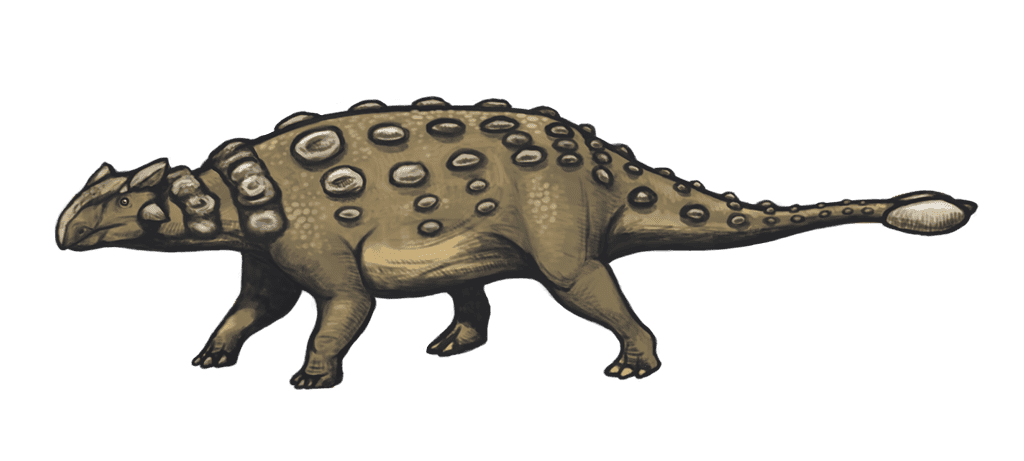
Ankylosaurus, known for its heavily armored body and club-like tail, was a fortress on legs. Discovered in the early 20th century, this dinosaur roamed North America in the Late Cretaceous. This tank could grow up to 10 meters in length and featured a broad, robust body covered in thick, bony plates and knobs. The tail club, an extension of its vertebrae, most likely served as a defensive weapon against predators and among themselves.
The armor of Ankylosaurus not only served as protection but also may have been involved in thermoregulation or species recognition. Living close to the ground, Ankylosaurus likely fed on low-growing vegetation. Its small, leaf-shaped teeth and powerful jaw muscles were well-suited for a diet of tough, fibrous plants.
5. Spinosaurus: “Spine Lizard”
| Family | Spinosauridae |
| Found in | Bahariya Formation, Egypt |
| Diet | Carnivorous |
| Lived | 100-94 mya |
| Length | 18 m |
| Height | 7.8 m |
| Weight estimate | 7000 kg |

Spinosaurus, recognized by the distinctive sail-like structure on its back, was a pretender to Tyrannosaurus‘ throne for the largest carnivore. Discovered in the early 20th century, this predator inhabited the regions of North Africa during the Late Cretaceous. Estimates suggest it reached lengths of up to 16 meters. The sail, formed by elongated vertebrae, might have served multiple purposes, including thermoregulation and display behaviors.
Recent fossil discoveries, particularly of its tail, have provided compelling evidence of this dinosaur’s aquatic capabilities. The newly found tail has a paddle-like structure for propulsion in water, suggesting that Spinosaurus sported a semi-aquatic lifestyle. This finding has revolutionized our understanding of Spinosaurus, painting a picture of a dinosaur that spent much of its time in water, akin to modern crocodiles. The elongated snout and conical teeth further indicate a diet primarily consisting of fish.
6. Therizinosaurus: “Schyte Lizard”
| Family | Therizinosauridae |
| Found in | Nemegt Formation, Mongolia |
| Diet | Herbivorous |
| Lived | 100-66 mya |
| Length | 11 m |
| Height | 5 m |
| Weight estimate | 5000 kg |
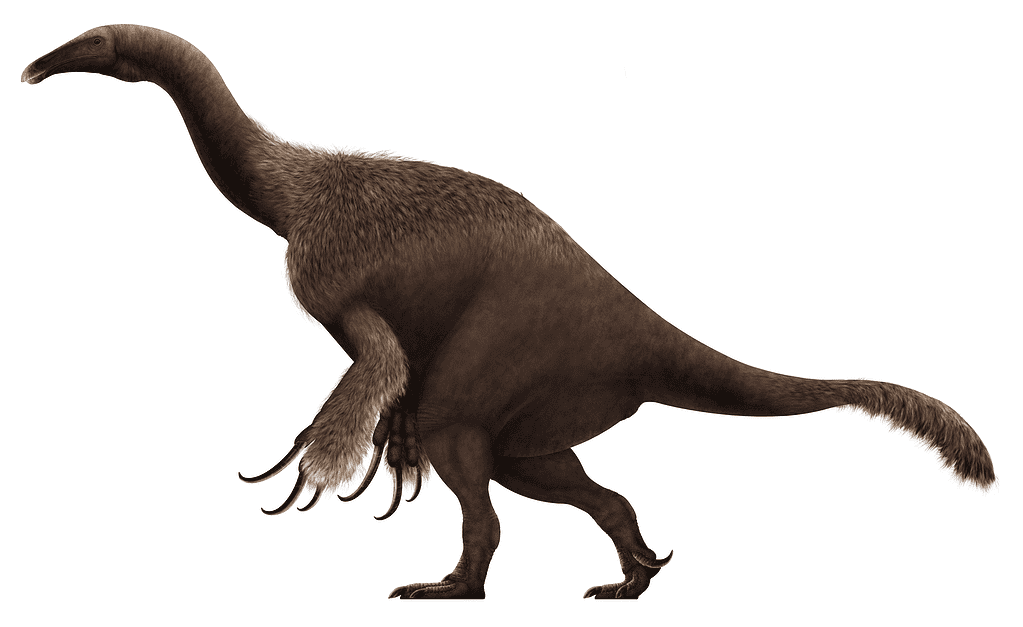
Therizinosaurus, known for its extraordinarily long, clawed forelimbs, remains one of the most peculiar dinosaurs ever discovered. First unearthed in the late 20th century, this dinosaur roamed Asia during the Late Cretaceous. The “scythe lizard” could have reached lengths of up to 11 meters and grow as tall as five meters. The most striking features of Therizinosaurus are its claws, which could grow up to one meter long. However, their exact function is still debated, with theories ranging from defense to foraging behavior.
Despite its fearsome claws, Therizinosaurus was a herbivore, possessing a broad, bulky body and a wide beak-like mouth suited for clipping vegetation. Its long neck allowed it to reach high vegetation, suggesting a feeding strategy similar to modern giraffes. The peculiar body structure of Therizinosaurus, combining formidable claws with a herbivorous diet, highlights the diverse evolutionary paths taken by dinosaurs.
7. Argentinosaurus: “Argentina Lizard”
| Family | Titanosauria |
| Found in | Neuquén, Argentina |
| Diet | Herbivorous |
| Lived | 96-92 mya |
| Length | 35 m |
| Height | 14 m |
| Weight estimate | 50,000-100,000 kg (I am just as amazed) |
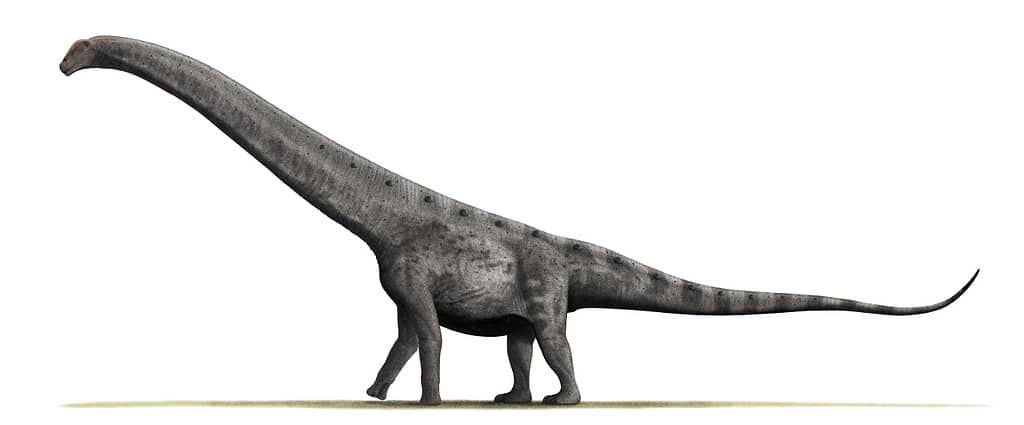
Absolutely immense, the Argentinosaurus is THE largest land animal paleontologists have ever discovered. This colossal sauropod first emerged in the late 20th century in Argentina and lived during the Late Cretaceous. Estimates of its size suggest it could reach lengths of up to 37 meters and weigh an outstanding 100 tons. Its enormous vertebrae and limb bones support these estimates.
Due to its fragmentary remains, we know very little about the detailed anatomy of Argentinosaurus. Its size has led paleontologists to consider the implications of its growth rate, metabolism, and the amount of food it needs to consume to sustain itself. This titanosaur would have had to eat vast quantities of vegetation daily, thus living in areas rich in plant life. It likely had a long neck and tail, and its body structure suggests a slow-moving, quadrupedal lifestyle. Its size would have been a deterrent to predators, and it likely fed on high vegetation that smaller herbivores could not reach.
8. Shantungosaurus: “Shandong Lizard”
| Family | Hadrosauridae |
| Found in | Shandong, China |
| Diet | Herbivorous |
| Lived | 83-74 mya |
| Length | 15 m |
| Height | 7 m |
| Weight estimate | 20,000 kg |
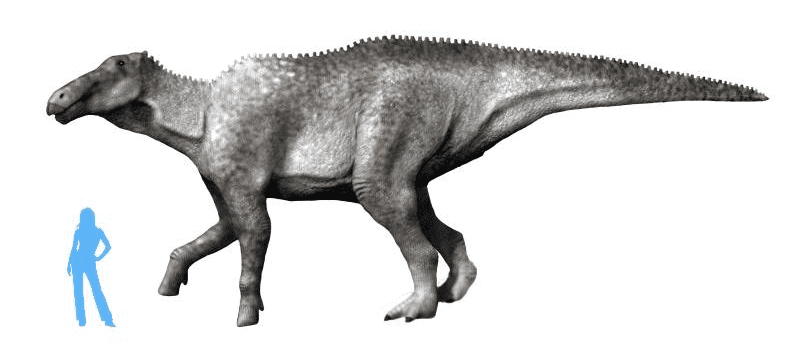
Also absolutely immense, Shantungosaurus is the largest known ornithopod dinosaur. This hadrosaur was discovered in the mid-20th century in the Shandong Province of China. Fossil records suggest it could reach up to 15 meters in length and towered seven meters tall. Its size and build classify it as the largest non-sauropod dinosaur.
Characterized by a long, flat skull and a beak suited for cropping vegetation, Shantungosaurus was likely a forager. The limb proportions of Shantungosaurus indicate a primarily bipedal stance, allowing it to cover large distances in search of food and potentially reach higher vegetation. However, its forelimbs were also robust, suggesting it could also adopt a quadrupedal stance, especially while foraging. The dental arrangement of Shantungosaurus, featuring hundreds of tightly packed teeth, was well adapted for grinding tough plant material, indicating a diet consisting predominantly of fibrous vegetation.
9. Iguanodon: “Iguana Tooth”
| Family | Iguanodontidae |
| Found in | Sussex, England |
| Diet | Herbivorous |
| Lived | 140-110 mya |
| Length | 9 m |
| Height | 2 m |
| Weight estimate | 4000 kg |
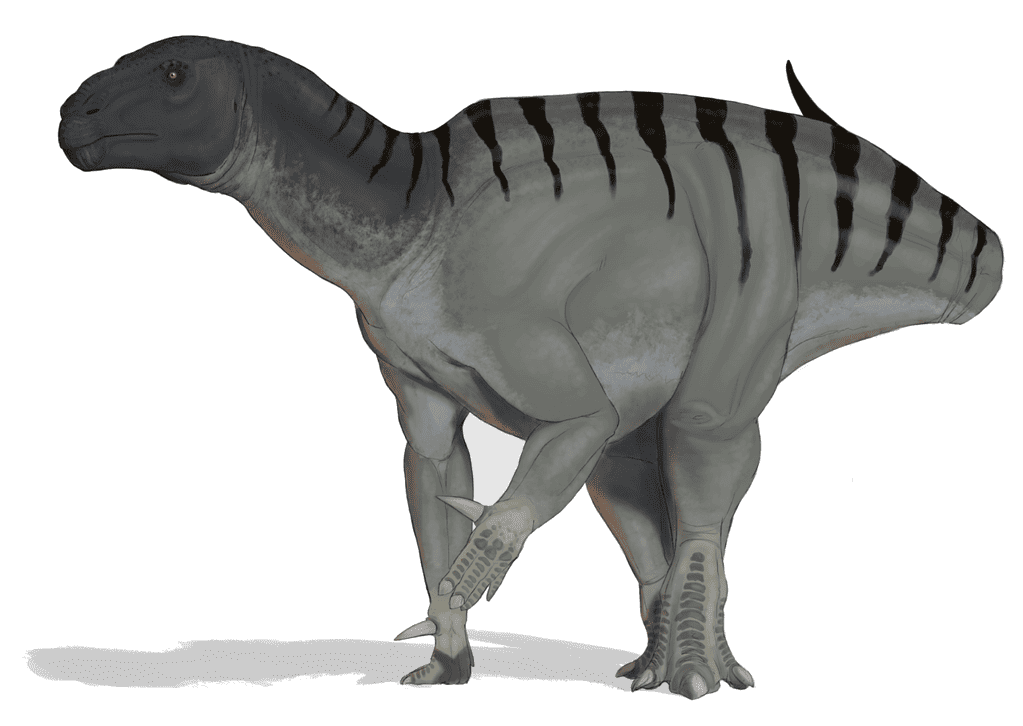
Alada… I mean, Iguanodon, is history’s second discovered species of dinosaur, first unearthed in the early 19th century. Its initial reconstructions were based on fragmentary remains, leading to several inaccuracies in understanding its appearance and lifestyle. The most famous misinterpretation was the thumb spike initially placed on the dinosaur’s nose, leading scientists to believe it was a horned creature. Over time, as more complete skeletons emerged, paleontologists painted a clearer picture of Iguanodon.
Paleontologists realized that the thumb spike was not a nasal horn but a defensive weapon or a tool for foraging. Iguanodon had a robust build, reaching up to 10 meters in length. Its beaked mouth and rows of grinding teeth suggest a diet primarily composed of tough vegetation. Its hoof-like fingers suggest it was mostly quadrupedal, while its strong hind limbs allowed for efficient bipedal movement when necessary.
10. Pachycephalosaurus: “Thick-Headed Lizard”
| Family | Pachycephalosauridae |
| Found in | Lance Formation, Montana |
| Diet | Herbivorous |
| Lived | 100-66 mya |
| Length | ~5 m |
| Height | ~2 m |
| Weight estimate | 370-450 kg |
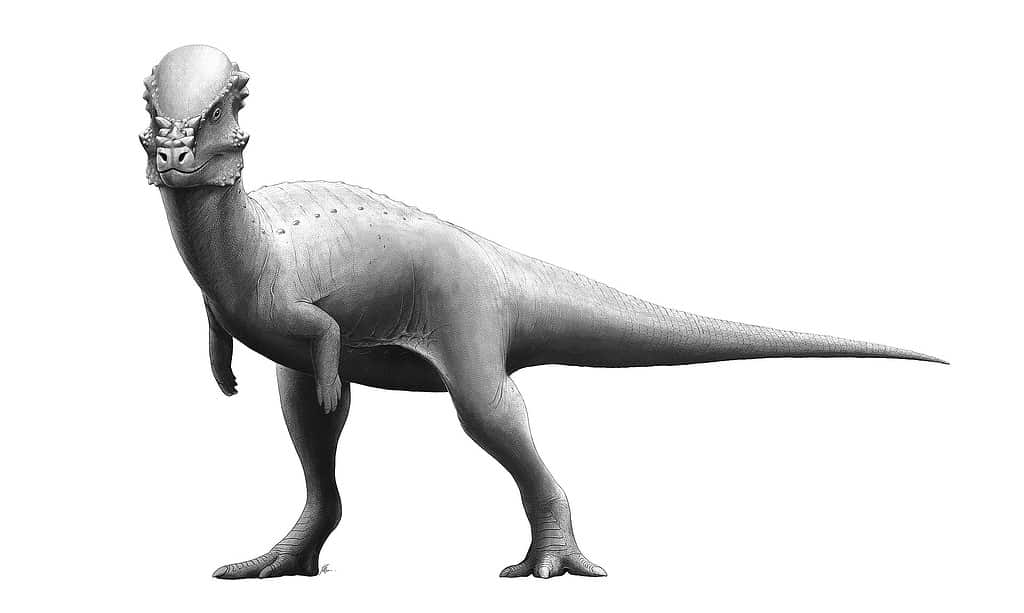
Pachycephalosaurus, known for its iconic thick, bony skull dome, inhabited North America during the Late Cretaceous. Discovered in the mid-20th century, it was a medium-sized dinosaur, reaching lengths of about five meters. Pachycephalosaurus’ hallmark is its dome, up to 25 centimeters thick, which initially led to speculation about its use in head-to-head combat, similar to modern-day rams.
However, recent analyses suggest that the dome structure might not have been able to absorb such impacts as previously thought. Instead, the dome’s bone structure suggests it may have been used for social purposes, featuring colorful displays to attract mates. Pachycephalosaurus was a herbivore, with a beak and small teeth for cropping and consuming plant material.
Now read:


